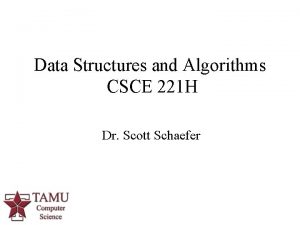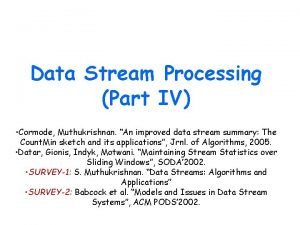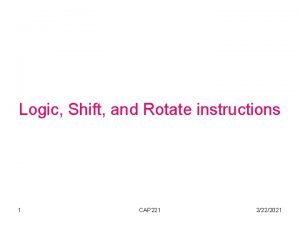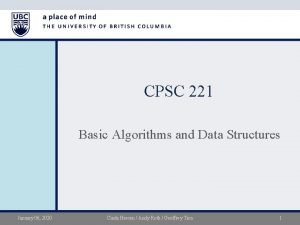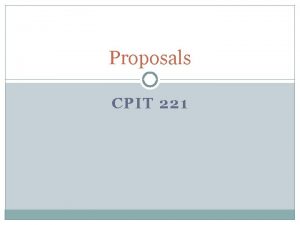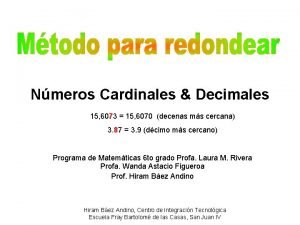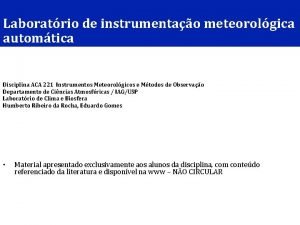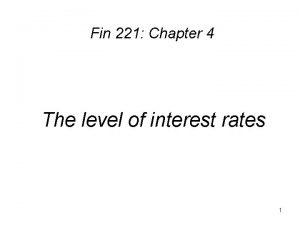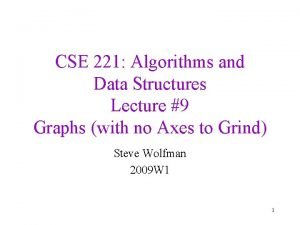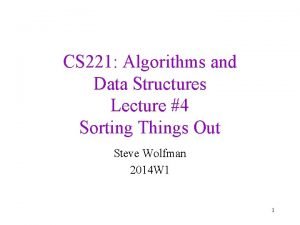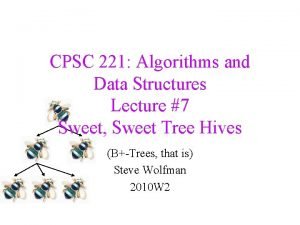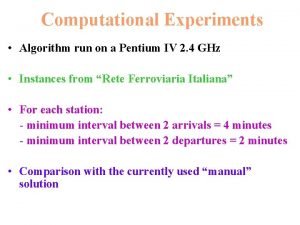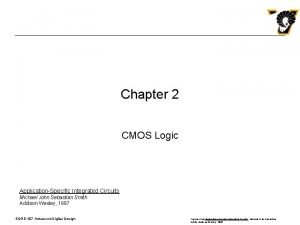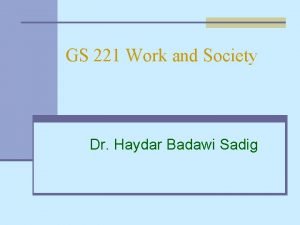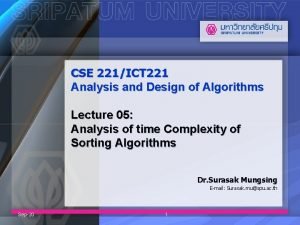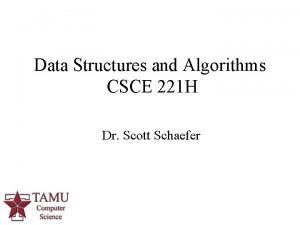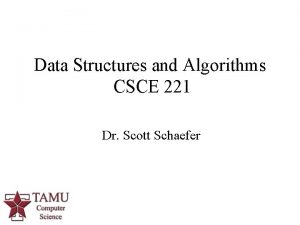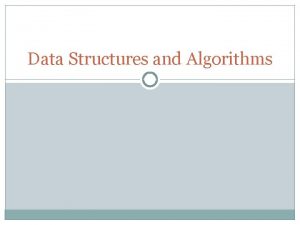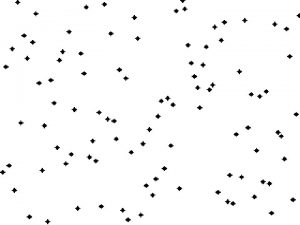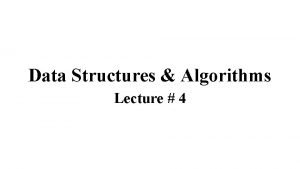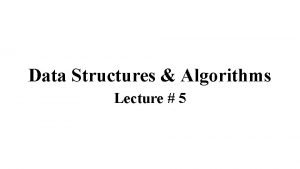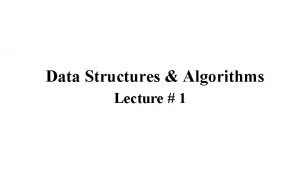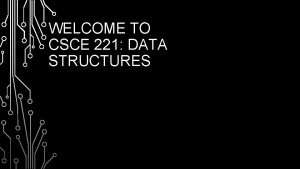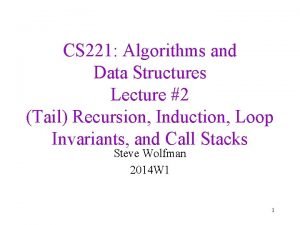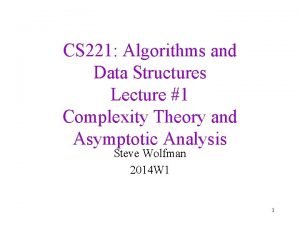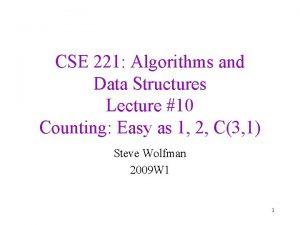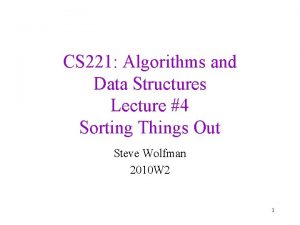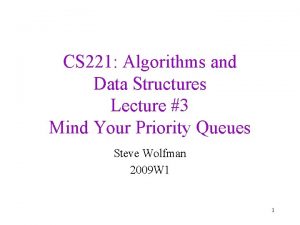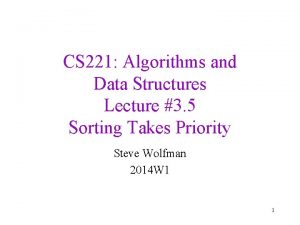Data Structures and Algorithms CSCE 221 H Dr






































- Slides: 38

Data Structures and Algorithms CSCE 221 H Dr. Scott Schaefer 1

Staff n n n Instructor u Dr. Scott Schaefer u HRBB 304 A u Office Hours: TR 8 am-9 am (or by appointment) TA u Harish Kumar u EABB u Office Hours: TR noon-1 pm Peer Teachers u Nathan Brockway, Dominick Fabian u Peer Teacher Central (HRBB 129) 2/38

What will you learn? n n n n n Analysis of Algorithms Stacks, Queues, Deques Vectors, Lists, and Sequences Trees Priority Queues & Heaps Maps, Dictionaries, Hashing Skip Lists Binary Search Trees Sorting and Selection Graphs 3/38

Prerequisites n CSCE 121 “Introduction to Program Design and Concepts” n CSCE 222 “Discrete Structures” or MATH 302 “Discrete Mathematics” (either may be taken concurrently with CSCE 221) 4/38

Textbook 5/38

Grading 3% Labs n 12% Homework n 5% Culture Assignments n 30% Programming Assignments n 10% Quizzes n 20% Midterm n 20% Final n 6/38

Assignments Turn in code/homeworks via Google Classroom (invitation code gpj 6 ff) n Due by 11: 59 pm on day specified n All programming in C++ n Code, proj file, sln file, and Win 32 executable n Make your code readable (comment) n You may discuss concepts, but coding is individual (no “team coding” or web) n 7/38

Late Policy Penalty = m: number of minutes late percentage penalty n days late 8/46

Late Policy Penalty = m: number of minutes late percentage penalty n days late 9/46

Late Policy Penalty = m: number of minutes late percentage penalty n days late 10/46

Late Policy Penalty = m: number of minutes late percentage penalty n days late 11/46

Labs n Several structured labs at the beginning of the semester with (simple) exercises u Graded on completion u Time to work on homework/projects 12/38

Homework Approximately 5 n Written/Typed responses n Simple coding if any n 13/38

Programming Assignments About 5 throughout the semester n Implementation of data structures or algorithms we discusses in class n Written portion of the assignment n 14/38

Quizzes Approximately 10 throughout the semester n Short answer, small number of questions n Will only be given in class or lab u Must be present to take the quiz n 15/38

Culture Assignments Two research seminar reports u One before Spring break, one after n Biography of a famous Computer Scientist u 5 minute presentation u Signup this week by sending me an email n n http: //faculty. cs. tamu. edu/schaefer/teaching/221_Fall 2018/Assignments/culture. html 16/38

Academic Honesty Assignments are to be done on your own u May discuss concepts, get help with a persistent bug u Should not copy work, download code, or work together with others unless specifically stated otherwise n We use a software similarity checker u http: //moss. stanford. edu n 17/38

Class Discussion Board n piazza. com/tamu/fall 2018/csce 221200 18/38

Asymptotic Analysis 19/38

Running Time n n The running time of an algorithm typically grows with the input size. Average case time is often difficult to determine. We focus on the worst case running time. u u Crucial to applications such as games, finance, and robotics Easier to analyze worst case 5 ms Running Time n 4 ms 3 ms best case 2 ms 1 ms A B C D E Input Instance F G 20/38

Experimental Studies n n Write a program implementing the algorithm Run the program with inputs of varying size and composition Use a method like clock() to get an accurate measure of the actual running time Plot the results 21/38

Stop Watch Example 22/38

Limitations of Experiments It is necessary to implement the algorithm, which may be difficult n Results may not be indicative of the running time on other inputs not included in the experiment. n In order to compare two algorithms, the same hardware and software environments must be used n 23/38

Theoretical Analysis Uses a high-level description of the algorithm instead of an implementation n Characterizes running time as a function of the input size, n. n Takes into account all possible inputs n Allows us to evaluate the speed of an algorithm independent of the hardware/software environment n 24/38

Important Functions n Seven functions that often appear in algorithm analysis: u u u u Constant 1 Logarithmic log n Linear n N-Log-N n log n Quadratic n 2 Cubic n 3 Exponential 2 n 25/38

Important Functions n Seven functions that often appear in algorithm analysis: u u u u Constant 1 Logarithmic log n Linear n N-Log-N n log n Quadratic n 2 Cubic n 3 Exponential 2 n 26/38

Why Growth Rate Matters if runtime is. . . time for n + 1 time for 2 n time for 4 n c lg (n + 1) c (lg n + 1) c(lg n + 2) cn c (n + 1) 2 c n 4 c n lg n ~ c n lg n + cn 2 c n lg n + 2 cn 4 c n lg n + 4 cn c n 2 ~ c n 2 + 2 c n 4 c n 2 16 c n 2 c n 3 ~ c n 3 + 3 c n 2 8 c n 3 64 c n 3 c 2 n c 2 n+1 c 2 2 n c 2 4 n runtime quadruples when problem size doubles 27/38

Comparison of Two Algorithms insertion sort is n 2 / 4 merge sort is 2 n lg n sort a million items? insertion sort takes roughly 70 hours while merge sort takes roughly 40 seconds This is a slow machine, but if 100 x as fast then it’s 40 minutes versus less than 0. 5 seconds 28/38

Constant Factors n The growth rate is not affected by u u n constant factors or lower-order terms Examples u u 102 n + 105 is a linear function 105 n 2 + 108 n is a quadratic function 29/38

Big-Oh Notation n n Given functions f(n) and g(n), we say that f(n) is O(g(n)) if there are positive constants c and n 0 such that f(n) cg(n) for n n 0 Example: 2 n + 10 is O(n) u u 2 n + 10 cn (c 2) n 10/(c 2) Pick c = 3 and n 0 = 10 30/38

Big-Oh Example n Example: the function n 2 is not O(n) u u u n 2 cn n c The above inequality cannot be satisfied since c must be a constant 31/38

More Big-Oh Examples 7 n-2 is O(n) need c > 0 and n 0 1 such that 7 n-2 c • n for n n 0 this is true for c = 7 and n 0 = 1 n 3 n 3 + 20 n 2 + 5 is O(n 3) need c > 0 and n 0 1 such that 3 n 3 + 20 n 2 + 5 c • n 3 for n n 0 this is true for c = 4 and n 0 = 21 n 3 log n + 5 is O(log n) need c > 0 and n 0 1 such that 3 log n + 5 c • log n for n n 0 this is true for c = 8 and n 0 = 2 32/38

Big-Oh and Growth Rate n n n The big-Oh notation gives an upper bound on the growth rate of a function The statement “f(n) is O(g(n))” means that the growth rate of f(n) is no more than the growth rate of g(n) We can use the big-Oh notation to rank functions according to their growth rate g(n) grows more f(n) grows more Same growth f(n) is O(g(n)) g(n) is O(f(n)) Yes No Yes 33/38

Big-Oh Rules n If is f(n) a polynomial of degree d, then f(n) is O(nd), i. e. , 1. 2. n Use the smallest possible class of functions u n Drop lower-order terms Drop constant factors Say “ 2 n is O(n)” instead of “ 2 n is O(n 2)” Use the simplest expression of the class u Say “ 3 n + 5 is O(n)” instead of “ 3 n + 5 is O(3 n)” 34/38

Computing Prefix Averages n n We further illustrate asymptotic analysis with two algorithms for prefix averages The i-th prefix average of an array X is average of the first (i + 1) elements of X: A[i] = (X[0] + X[1] + … + X[i])/(i+1) 35/38

Prefix Averages (Quadratic) The following algorithm computes prefix averages in quadratic time by applying the definition Algorithm prefix. Averages 1(X, n) Input array X of n integers Output array A of prefix averages of X #operations A new array of n integers n for i 0 to n 1 do n s X[0] n for j 1 to i do 1 + 2 + …+ (n 1) s s + X[j] 1 + 2 + …+ (n 1) A[i] s / (i + 1) n return A 1 36/38

Arithmetic Progression n The running time of prefix. Averages 1 is O(1 + 2 + …+ n) The sum of the first n integers is n(n + 1) / 2 Thus, algorithm prefix. Averages 1 runs in O(n 2) time 37/38

Prefix Averages (Linear) The following algorithm computes prefix averages in linear time by keeping a running sum Algorithm prefix. Averages 2(X, n) Input array X of n integers Output array A of prefix averages of X A new array of n integers s 0 for i 0 to n 1 do s s + X[i] A[i] s / (i + 1) return A #operations n 1 n n n 1 Algorithm prefix. Averages 2 runs in O(n) time 38/38
 Csce 221 tamu
Csce 221 tamu Csce 221 tamu syllabus
Csce 221 tamu syllabus Csce 222
Csce 222 Data structures and algorithms iit bombay
Data structures and algorithms iit bombay Cos 423 princeton
Cos 423 princeton Data structures and algorithms tutorial
Data structures and algorithms tutorial Information retrieval data structures and algorithms
Information retrieval data structures and algorithms Data structures and algorithms bits pilani
Data structures and algorithms bits pilani Data structures and algorithms iit bombay
Data structures and algorithms iit bombay Data structures and algorithms
Data structures and algorithms Data structures and algorithms
Data structures and algorithms Waterloo data structures and algorithms
Waterloo data structures and algorithms Signature file structure in information retrieval system
Signature file structure in information retrieval system Data structures and algorithms
Data structures and algorithms Algorithms + data structures = programs
Algorithms + data structures = programs Examples of homologous
Examples of homologous Stream data model
Stream data model Rotational statics
Rotational statics People first timesheet
People first timesheet Difference between arithmetic shift and logical shift
Difference between arithmetic shift and logical shift Sp 221
Sp 221 Emmett bond results
Emmett bond results Epsc 221
Epsc 221 Cpsc 221 ubc
Cpsc 221 ubc Cpit 221
Cpit 221 221 - 206
221 - 206 Cpit 221
Cpit 221 Redondear a diezmilesimos
Redondear a diezmilesimos Aca 221
Aca 221 Fin221
Fin221 Cse 221
Cse 221 Cs 221
Cs 221 Cpsc 221
Cpsc 221 Lagr 221
Lagr 221 Kondensator adalah
Kondensator adalah Aoi 221 gate
Aoi 221 gate Edu-221
Edu-221 Gs-221
Gs-221 Cse 221
Cse 221


